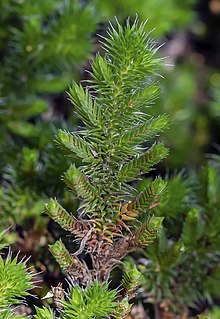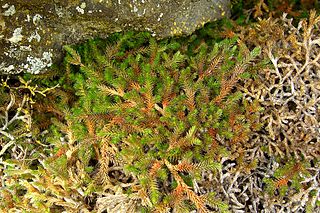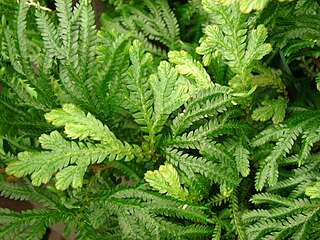
Selaginella is the sole genus of vascular plants in the family Selaginellaceae, the spikemosses or lesser clubmosses.

Triadenum, known as marsh St. John's worts, is a small genus of flowering plants in the family Hypericaceae. The genus is characterized by opposite, blunt-tipped leaves and pink flowers with 9 stamens. They are distributed in North America and eastern Asia.

Selaginella apoda, commonly known as meadow spikemoss, is a perennial lycophyte native to much of the eastern United States and parts of northeastern Mexico. The life cycle is the shortest of the genus Selaginella, as well as one of the shortest among the lycophytes. Selaginella apoda is found primarily in damp soils in habitats such as swamps, wet fields, open woods and along stream banks. Selaginella apoda presents the potential for case studies involving the plant's adaptability to environmental toxins. A lowland plant, it has only been recorded at elevations below 100 meters. It is closely related to Selaginella eclipes and S. ludoviciana, with both of which it has been reported to form hybrids. This group is characterized by relatively flat strobili and large megasporophylls which occur in the same plane as the lateral leaves.

Selaginella selaginoides is a non-flowering plant of the spikemoss genus Selaginella with a wide distribution around the Northern Hemisphere. It resembles a moss in appearance but is a vascular plant belonging to the division Lycopodiophyta. It has a number of common names including lesser clubmoss, club spikemoss, northern spikemoss, low spikemoss and prickly mountain-moss. This plant has one close relative, Selaginella deflexa, native to Hawaii. These two plants form a small clade that is sister to all other Selaginella species.

Selaginella kraussiana is a species of vascular plant in the family Selaginellaceae. It is referred to by the common names Krauss' spikemoss, Krauss's clubmoss, or African clubmoss, and is found naturally in parts of Sub-Saharan Africa and in Macaronesia. It belongs to the very ancient lineage of plants known as the clubmosses.
Selaginella asprella is a species of spikemoss known by the common name bluish spikemoss. It is native to California and Baja California, where it has a disjunct distribution, occurring in the Klamath Mountains and mountain ranges several hundred miles to the south. It grows in rocky mountainous habitat, on cliffs of limestone rock substrate, and on forest ridges. This lycophyte grows in flat mats with many short, forking stems twisted together. The stems fragment easily, especially as they dry. The lance-shaped green leaves are up to 5 or 6 millimeters long, including the soft bristles at their tips. The leaves are alike in shape and borne in squarish whorls of four about the stem. They are flattened to the stem.

Selaginella bigelovii is a species of spikemoss known by the common names bushy spikemoss and Bigelow's spikemoss. It is native to California and Baja California, where it grows in rocky places in many different habitat types, from the coastline to the mountains to the deserts. This lycophyte forms clumps of spreading upright to erect stems up to 20 centimeters long with a few short lateral branches. The linear or lance-shaped green leaves are up to 4 millimeters long, including the tiny rigid bristles at their tips. They are flattened to the stem or stick out just a little. The strobili borne at the leaf bases are yellow-orange in color.

Selaginella cinerascens is a species of spikemoss known by the common names mesa spikemoss, gray spikemoss, and ashy spikemoss. It is native to Baja California as well as some locations just north of the border in San Diego County, California. It grows in dry habitat, often on clay soil, both in open areas and in the shade of larger plants. This lycophyte forms mats of spreading, forking stems up to 18 centimeters long. The plant is often gray or brown in color, forming a dull-colored carpet on the substrate. The linear or lance-shaped leaves are 1 to 3 millimeters long and lack bristles at the tips. The leaves are green when new or moist. They are flattened to the stem or stick out just a little. The strobili borne at the leaf bases are yellow in color and no more than 4 to 5 millimeters long.

Selaginella densa is a species of spikemoss known by the common names lesser spikemoss, prairie spikemoss, and Rocky Mountains spikemoss. It is native to western North America, where it can be found from Alaska to Ontario, the Dakotas, Texas and far northern California.

Selaginella eremophila is a species of spikemoss known by the common name desert spikemoss. It is native to the deserts and adjacent mountains around the intersection of California and Arizona with Baja California. It grows in sandy and rocky habitat. This lycophyte forms dense mats of spreading stems with small, forking branches. The lance-shaped leaves are up to 3 millimeters long on the lower stem surfaces and a little shorter on the upper sides. The tiny leaves have pointed tips with soft, twisted bristles. The strobili bearing the reproductive parts are under a centimeter long.

Selaginella hansenii is a species of spikemoss known by the common name Hansen's spikemoss. It is endemic to California where it can be found throughout the central part of the state, from the lowest reaches of the Cascade Range through the Central Coast Ranges and Sierra Nevada to the southern end of the Central Valley and the Tehachapis. It can be found in varied rocky habitat in hills and mountains. This lycophyte forms loose or dense mats of spreading stems with small, forking branches. The lance-shaped or triangular leaves are up to 5 or 6 millimeters long including the soft, white bristles at the tips. The leaves are green, often tinged with red, or totally red. The strobili containing the reproductive structures are under a centimeter long.

Selaginella oregana is a species of spikemoss known by the common name Oregon spikemoss. It is native to the Pacific Coast of western North America, where it can be found from British Columbia to northern California. It grows in mossy, shady coastal forests. It is often epiphytic, growing attached to tree branches, its stems hanging in sheets of green, mosslike streamers. Trees commonly occupied by the spikemoss include bigleaf maple, black cottonwood, and red alder. It also grows on the ground and on rocks in carpetlike mats. This lycophyte has creeping or hanging stems up to about 60 centimeters long, usually with forking branches. They curl as they dry. The stems are radially symmetric, with spirals of lance-shaped leaves each measuring 2 or 3 millimeters in length and tipped with a tiny, rigid bristle. The strobili containing the reproductive structures are up to 6 centimeters long and often occur in pairs.

Selaginella wallacei is a species of spikemoss known by the common name Wallace's spikemoss. It is native to western North America from British Columbia to California to Montana, where it can be found in many types of habitat, including open and shaded areas, and wet to dry environments, often growing on and over rocks. This lycophyte is variable in appearance, its form depending on the habitat it grows in. It can be spreading with many narrow branches, or a small, dense mat. The forking stems grow up to about 25 centimeters long, but may remain much shorter in dry conditions. They are lined with linear, lance-shaped, or oblong leaves up to 4 millimeters long including the bristles at the tips. The strobili containing the reproductive structures may be quite long, reaching up to 9 centimeters.
Selaginella watsonii is a species of spikemoss known by the common name Watson's spikemoss. It is native to the western United States, where it grows in many rocky habitat types, including high mountain peaks in alpine climates. This lycophyte forms mats or cushions of short, forking stems. They are lined with linear or lance-shaped leaves no more than 4 millimeters long, often tipped with tiny bristles. The strobili containing the reproductive structures are 1 to 3 centimeters long.

Selaginella plana, commonly known as the Asian spikemoss, is a lycophyte native to tropical Asia.
Selaginella stellata, also recognized by its common name, starry spikemoss or starry spike-moss, is a species of spikemoss of the family Selaginellaceae. It is a type of lycopod that grows naturally in Mexico and Central American countries like Guatemala and Belize and can also be found in the state of Hawaii.

Selaginella tortipila is a species of clubmoss in the family Selaginellaceae. It is referred to by the common names twistedhair spikemoss or kinky-hair spike-moss, and is a member of an early diverging group of plants. It is native to the Southeastern United States where it is found in a small area in the Southern Appalachian Mountains and Piedmont. It is found on granite or sandstone rock outcrop communities, often at high elevation.

Selaginella substipitata, the stalked spikemoss, is a species of plant in the Selaginellaceae family, endemic to Caribbean islands, Colombia, and Venezuela.

Selaginella willdenowii is a species of vascular plant in the Selaginellaceae family. It is a spikemoss known by the common names Willdenow's spikemoss and peacock fern due to its iridescent blue leaves. Like other Selaginallales, it is fern ally and not a true fern.
Peacock fern is a common name for several plants and may refer to:
















